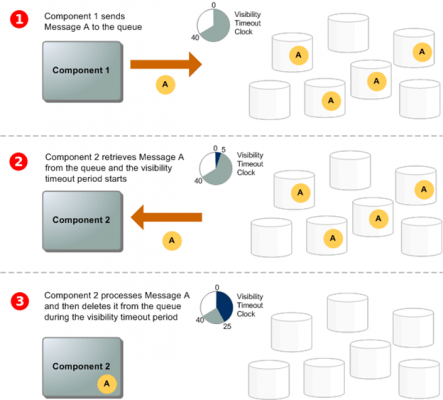Understanding SQS
Here, we will create an understanding of SQS.
- Reliable, scalable, hosted queue service for sending, storing and retrieving messages.
- Queue act as a buffer between sender and receiver.
- 256kb message, >256kb managed using SQS extended client library which uses S3, deliver message atleast once, not FIFO, can be create in
- any region, retained for 14 days
- can be sent and read simultaneously
- long polling reduces frequent polling (wait 20 secs if queue empty)
- First 1 million request free, $0.50 next 1 million + data transfer charges, SQS queues can be scaled.
- Amazon SQS Architectures
- Priority (2 queues High/Low)
- Fanout (SNS topic/multiple SQS queues for parallel processing)
- This supports both standard and FIFO queues.
- Standard Queue
- Unlimited Throughput
- At-Least-Once Delivery
- Best-Effort Ordering
- FIFO Queue
- High Throughput
- Exactly-Once Processing
- First-In-First-Out Delivery
Distributed Queues
3 parts in a distributed messaging system
- the components of distributed system
- queue (distributed on Amazon SQS servers),
- messages in the queue.
Below, system send messages to queue and receive messages from queue. The queue (holds messages A through E) redundantly stores the messages across multiple Amazon SQS servers.

Message Lifecycle

- A producer or component 1 sends message A to a queue, and the message distribute across the Amazon SQS servers redundantly.
- When a consumer or component 2 is ready to process messages, it consumes messages from the queue, and message A returns. While message A is being processed, it remains in the queue and isn’t returned to subsequent receive requests for the duration of the visibility timeout.
- The consumer or component 2 deletes message A from the queue to prevent the message from being received and processed again when the visibility timeout expires.
Best Practices
- Processing Messages in a Timely Manner
- Handling Request Errors
- Setting Up Long Polling
- Capturing Problematic Messages
- Setting Up Dead-Letter Queue Retention
- Avoiding Inconsistent Message Processing
- Implementing Request-Response Systems
To reduce costs, batch message actions:
- use the Amazon SQS batch API actions
- use long polling together with buffered asynchronous client.
AWS Certified DevOps Engineer Free Practice TestTake a Quiz
